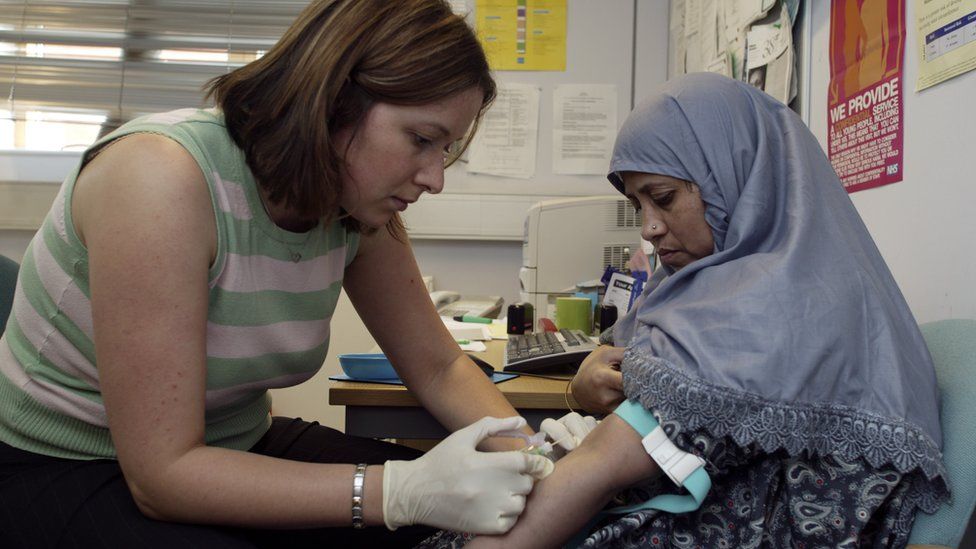Scotland has more GPs than rest of the UK, study finds
- Published

Scotland has the highest number of GPs per head of population in the UK, research commissioned by the BBC shows.
Analysis by the Nuffield Trust think tank shows there are 76 GPs per 100,000 people, compared to a national UK average of 60.
But Scotland's doctors have warned major challenges still exist with recruitment and retention.
The Scottish government has pledged to recruit a further 800 over the next decade to fill gaps.
The pressures on GPs across the UK are being examined by the BBC as part of a special day of coverage, including a Panorama investigation.
The UK-wide figures show there has been four consecutive years of falls with the biggest drops being seen in England.
Unlike south of the border, Scottish GP numbers have stayed relatively static in recent years.
This comes against a backdrop of increased patient numbers, many elderly with complex medical needs, and a fall in the number of GP practices.
Latest figures also show a 8% drop in the number of GP surgeries since 2008, from 1,025 in 2008 to 944 last year.
Over the same period the number of registered patients has increased by 5% to 5.7m.
Analysis by Lisa Summers, BBC Scotland Health Correspondent
There are reasons why Scotland has a higher ratio of GPs to patients than other parts of the UK.
One is topography - in parts of the Highlands, one GP may cover a vast area with a small number of inhabitants - and we have one of the largest island populations in Europe.
Most doctors say we still face a crisis in GP recruitment and retention, with high vacancy rates and almost a third of doctors nearing retirement age.
A commitment to recruit 800 family doctors by 2027 has been welcomed but even then there are worries that many of those jobs will be part-time ones and will still leave significant gaps.
The move to bigger practices with advanced nurse practitioners, pharmacists, physiotherapists and even paramedics taking on new roles is part of the answer, but there are recruitment problems in these professions too.
Significant gaps
Doctors in Scotland are being offered incentives such as "golden hello" payments or relocation costs as part of a plan to recruit 800 GPs in a decade.
The move is part of the new GP contract agreed in 2018 but unions say there are still significant gaps in GP numbers.
Dr Alasdair Forbes, of the Royal College of General Practitioners Scotland, warned that the country faces a shortfall of 856 family doctors by 2021.
He said: "Our members have told us that the current shortage of GPs is taking a toll on their wellbeing and reduces the likelihood that they will remain in general practice for the long-term.
"A commitment to increase the number of whole-time-equivalent GPs must be in tandem with the growth of the wider primary care team workforce such as nurses, pharmacists and physiotherapists.
"General practice is at the frontline of the NHS, carrying out the vast majority of patient contacts and holding clinical risk as gatekeepers to the other parts of the health service.
"By investing in general practice, the NHS will be enabled to be at its best where it is needed most, tackling many of the root causes of health inequalities and reducing the pressure on secondary care services."
When a GP's practice closes
Olive Watson, 93, has lived in the village of Stoneyburn all her life and can't remember a time when it didn't have a GP practice.
But that changed last year when the doctors who ran the West Lothian village's health centre handed the keys back to NHS Lothian.
The health board was unable to find a replacement, despite an extensive recruitment drive.
For Olive, who is registered blind, and the rest of the village this means the closest practice is three miles away in Fauldhouse.
"It is murder," Olive told BBC Scotland.
"It is just not convenient in anyway, when you get off the bus it is a hill and a bit of a walk to get there," said the pensioner, who now mostly relies on taxis to get to her new GPs.
"I would like to see a doctor, even part time, put in the village here, that would be handy for me and other people like me who are elderly but also young families.
"I met a lady with two kids who spent £12 going up and down to the doctor with one of them who was ill.
"You feel sorry for people like that, it is a lot of money in bus fares."
Olive, who also has asthma, said the village's surgery closing down had sometimes put her off going to see a GP.
She added: "If I am really very ill I phone for the paramedics and they are very good."
The UK-wide picture
The Nuffield Trust analysis looked at the number of GPs working in the NHS per 100,000 people across the UK.
It shows that during the late 1960s the numbers were falling, before four decades of almost continuous growth.
A peak of 66.5 was reached in 2009, before the increases tailed off.
There has now been four consecutive years of falls with the biggest drops being seen in England.
A Scottish government spokeswoman said: "We have a record number of GPs working in Scotland, and are committed to increasing numbers by at least 800 in the next 10 years.
"We are committed to investing £250m more in direct support of general practice by the end of this parliamentary period.
"The new GP contract agreed with the BMA and GPs, ensures GPs are able to spend more time with patients and less on bureaucracy, making a career in general practice even more attractive to younger doctors."
- Published18 January 2018
- Published1 June 2018
- Published4 February 2019